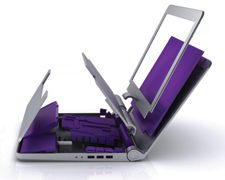Recyclable Laptops Signal New Era in Sustainable Design
As the demand for electronic devices continues to climb, so do the mountains of e-waste. Over 2 million tons of electronics became obsolete in 2005 according to US Environmental Protection Agency figures. Only 345,000 to 379,000 tons of which were recycled, leaving 1.5 to 1.8 million tons to spend out their lives in landfills. The issue of responsible disposal is more important than ever, especially considering the hazardous materials that go into making many of these devices, which can leach into the environment if proper measures are not followed. Adding to the confusion is the fact that consumers are mostly unaware of proper disposal methods, and the avenues that are available can be inconvenient or costly.
 One way to offset the growing e-waste problem is to create an easier path to recycling. An ounce of prevention is worth a pound of cure, the saying goes, so wouldn't it make sense to start treating recyclability as a design stage element? With exactly this in mind, a group of researchers set out to create a a recyclable laptop. Three Standford students along with four students from Finland's Aalto University came up with the idea as part of a graduate mechanical engineering course that challenged participants to address the real-world problem of e-waste.
One way to offset the growing e-waste problem is to create an easier path to recycling. An ounce of prevention is worth a pound of cure, the saying goes, so wouldn't it make sense to start treating recyclability as a design stage element? With exactly this in mind, a group of researchers set out to create a a recyclable laptop. Three Standford students along with four students from Finland's Aalto University came up with the idea as part of a graduate mechanical engineering course that challenged participants to address the real-world problem of e-waste.
"Almost everything in a laptop is theoretically recyclable," said Aaron Engel-Hall, one of the student researchers. "It's mostly metal, plastic and glass. The problem is that the metal, plastic and glass are completely integrated [with the rest of the laptop], and we need to separate them before they can be recycled."
3-D design software company Autodesk contributed the software design tools, which made the project possible, and after nine months of research and development, Bloom was born: a recyclable laptop that can be broken down into component parts without tools in less than 45 seconds. Once disassembled, some of the parts will be appropriate for local recycling programs, and pieces which require special handling, like printed circuit boards, battery, hard drive and screen, can be slipped into a pre-paid envelope for delivery to an appropriate facility.
As a consequence of society's electronic romance, e-waste volumes are predicted to peak at 73 million tons in 2015, according to Pike Research. At which point, sustainability policies are expected to kick in. While computer companies have shown interest in the Bloom prototype, there are no official plans underway to manufacturer it.










